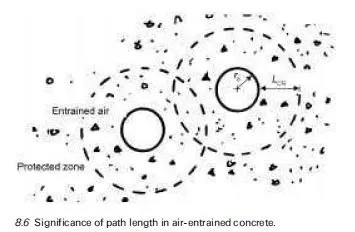A polymer impregnated concrete is produced via a process whereby an existing hardened concrete (structure or factory component) is dried at around 150ëC and then impregnated with a low viscosity monomer, usually methyl methacrylate, which is subsequently cured in situ. Impregnation is often achieved by soaking at atmospheric pressure although the process may be facilitated by evacuation and/or higher pressures. Polymerisation is accomplished by a thermal catalytic or promoted catalytic process or is radiation induced. The resulting polymer fills, or lines the surface, of the pores of the concrete modifying the properties of the hardened mortar. Extensive reviews of early work (Swamy, 1979; Shaw, 1989) showed that increases in modulus of elasticity, strength (compressive, flexural and tensile) and improvements in durability could be effected, although the extent of these improvements does depend on the depth of impregnation achieved and porosity of the original concrete. The process shows the most marked improvements when starting with high porosity, low compressive strength concretes. Since these reviews were written, there has been only a little additional investigative work reported (Ohama, 1997; Fowler, 1999). More recent work (Chen, 2005) has compared soaking time and polymerisation tem- perature on the mechanical properties of PIC in a systematic way and confirmed the possible improvements. Decreases in surface absorption compared with normal concrete are attributed to significant decreases in total porosity with maximum pore diameters of <50 nm. Despite the much improved properties and early application of PIC for remedial treatment of road bridge decks in the US, their high processing costs has generally precluded further use apart from limited precast operations in Japan, (Ohama, 1997).
However, one developing area where polymer impregnation may prove beneficial is the wear resistance of concrete used in floor construction. Treat- ments have been found to significantly increase the abrasion resistance of all types of concrete (Sadegzadeh, 1988), although improvements are greatest with low compressive strength concrete (Sebok, 2004).


